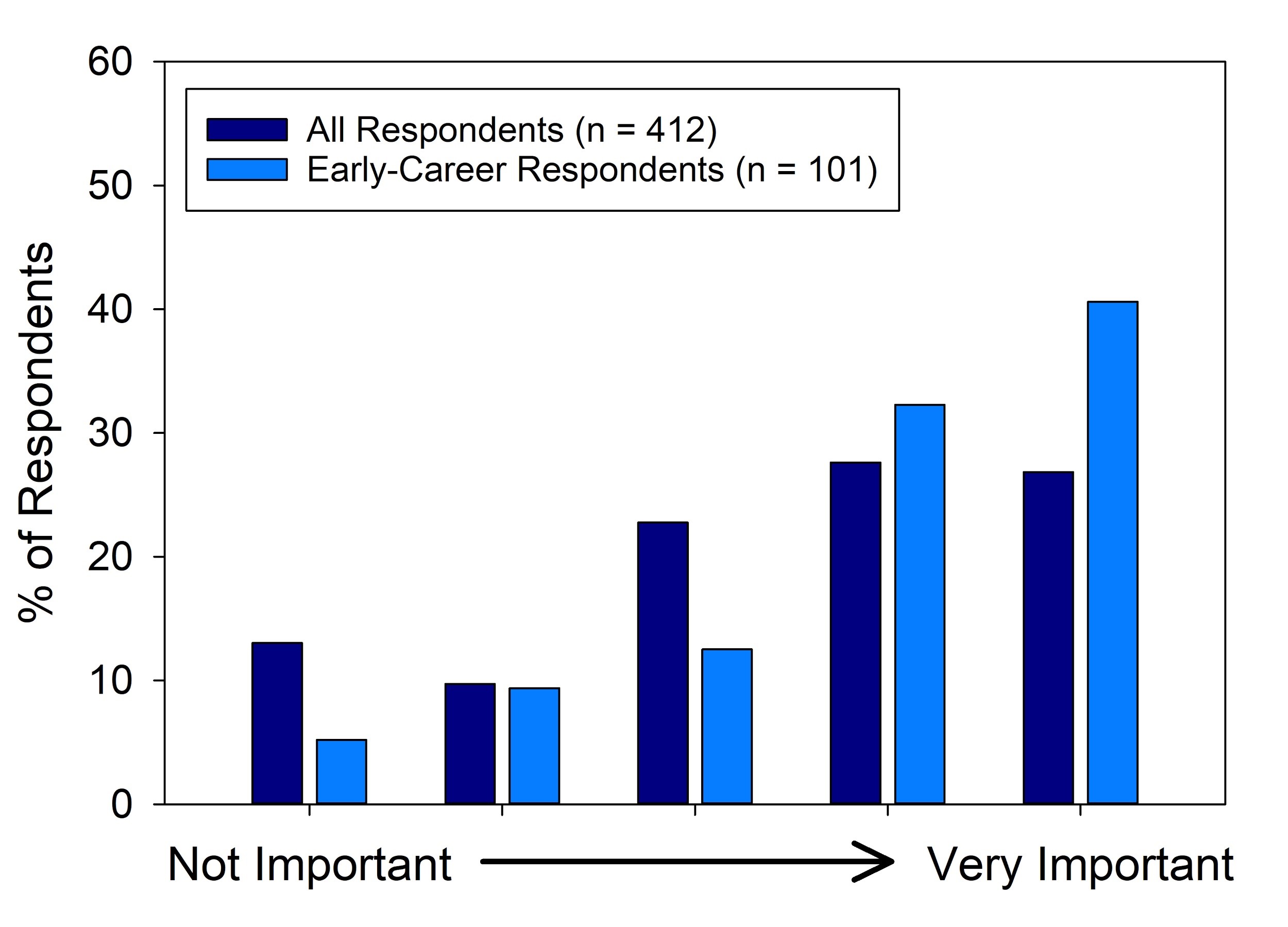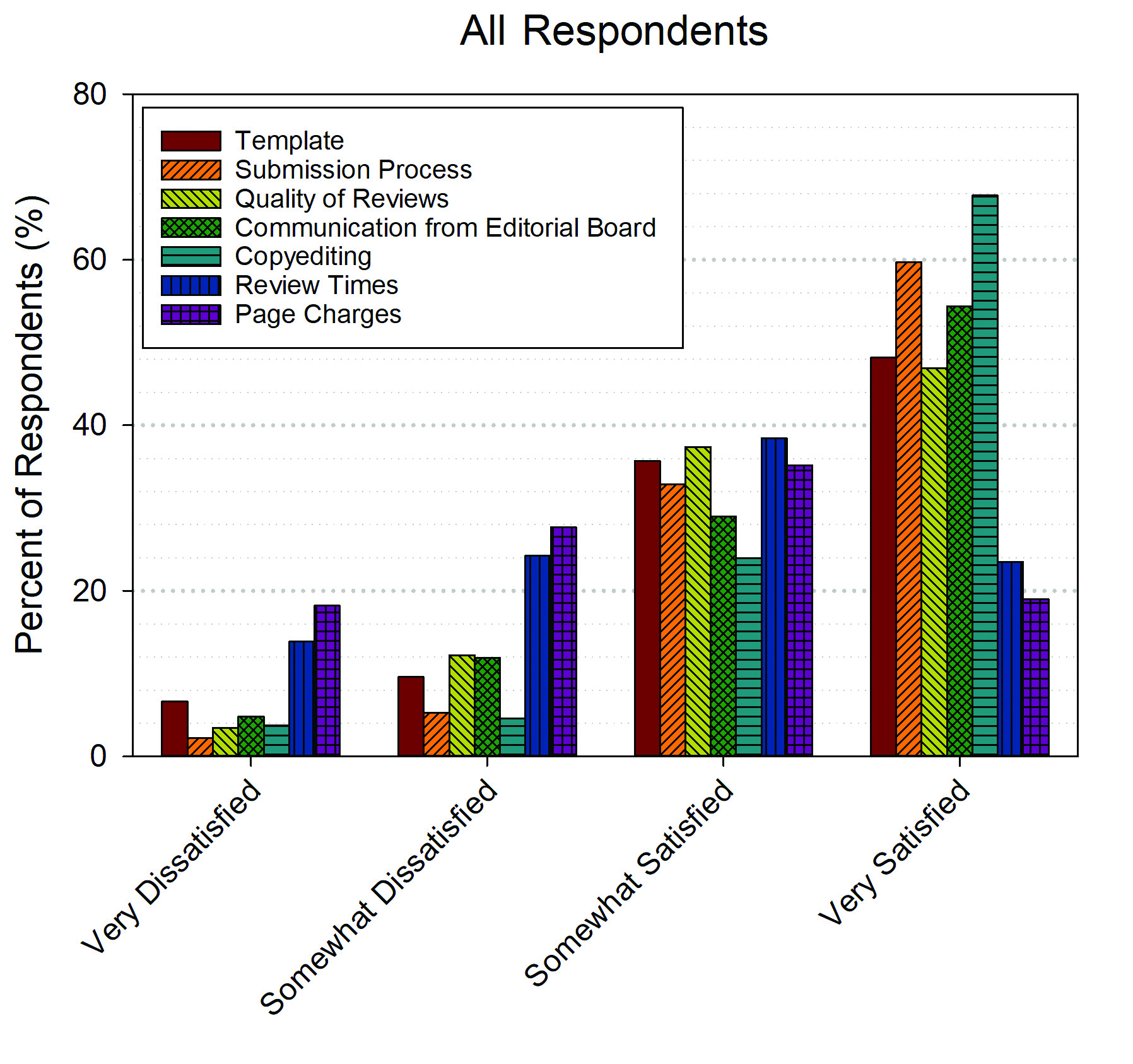Garey Fox, P.E.
Published in Resource magazine March/April 2020

Last year, the Editorial Board conducted a survey to gather information from the membership about the
perceived status of ASABE journals. We received 412 responses from authors in academia, government, and industry across all the ASABE technical communities. Thanks to everyone who participated and provided
feedback!
This article summarizes the insights gleaned from the survey results, such as how our member authors view the journal impact factor (JIF) and what are reasonable goals for the Society’s journals. The survey asked authors to rate their overall satisfaction with several aspects of the journals. Two
aspects received low ratings: the manuscript review time and the article processing charges (APCs). A distinguishing characteristic of the survey results was the career stage of the respondents; therefore, the survey results were analyzed for all respondents and then for early-career respondents (i.e., those
in the first ten years of their careers), who comprised 29.3% of the total respondents.
The Editorial Board is using that member feedback to guide improvements to the journals, such as allowing a wider range of article types (i.e., research articles, research briefs,
perspectives, frontiers, and invited reviews), establishing a double-blind peer-review process, adding article highlights, increasing the visibility of articles through social media, and more. We’re also considering some changes for the APCs, and we’re investing considerable effort to ensure that we meet
our goal of high-quality reviews within a reasonable time.
Journal Impact Factor
The JIF is the most common metric used for evaluating the prestige of scientific and technical journals. The two-year JIF for a specific year is calculated with the following equation, using 2019 as an example:

The current JIFs for ASABE journals are 1.153 for Transactions of the ASABE and 0.740 for Applied Engineering in Agriculture. Currently, the Journal of Agricultural Safety and Health does not have a JIF. While this two-year metric puts ASABE journals in a low-JIF category, our journals have an advantage in long-term impact. In fact, articles published in Transactions of the ASABE have a cited half-life of more than 14 years!
Researchers commonly assume that publishing in a journal with a higher JIF is better for ensuring the impact of their work, because the impact is based on the number of citations. However, while the JIF may be a useful metric for assessing the impact of a journal, more and more researchers are discovering that this metric can be ineffective for assessing the impact of a specific article. Nevertheless, JIF remains the metric most frequently used by administrative committees when assessing the potential impact of an author’s publications.
Do ASABE authors consider the JIF when choosing a journal for their research? In general, ASABE authors consider the JIF an important metric, and early-career members consider the JIF even more important, as shown in figure 1. What is the minimum JIF that ASABE journals need to encourage manuscript submissions? While many of the survey respondents suggested that they were not concerned about the JIF, most indicated that a JIF of about 2 or 3 would encourage submissions. Those values align with the Editorial Board’s goals.


Figure 1. The first graph shows the perceived importance of the journal impact factor (JIF) for the survey respondents when considering publishing. The second graph shows the minimum JIF that the survey respondents would like to see for ASABE journals.
Of course, there are ways to game the JIF and boost the number. However, the Editorial Board will not sacrifice ASABE’s commitment to publishing high-quality research through a sound peer-review process simply to increase an arbitrary journal metric.
Manuscript Review Time
The Editorial Board is working to ensure that manuscript review times are within the goal for ASABE journals (i.e., a median of 60 to 70 days for first decision), and we’re meeting
that goal, as shown in figure 2. Approximately 50% of the survey respondents indicated that a time to first decision of approximately 60 days was acceptable, and that percentage increased to nearly 80% for a first decision at 45 days. The authors were generally satisfied to very satisfied with the quality of the reviews they received, as shown in figure 3. We believe that a goal of 60 to 70 days for first decision is reasonable, considering the high quality of our reviews. Authors might receive faster reviews with other journals, but at the cost of valuable feedback on their work prior to publication.

Figure 2. Median and maximum review times to first decision for ASABE journals since 2010.


Figure 3. Satisfaction with various aspects of ASABE journals
for all respondents and for early-career members.
While ASABE journals are currently meeting the goal for time to first decision, some manuscripts get stalled in the review process, as indicated by the maximum time to first decision shown in figure 2. Some manuscripts have waited more than two years for a first decision. Such stalled manuscripts may have left some authors very dissatisfied with their review times, and this dissatisfaction was slightly more
prevalent for early-career authors, as shown in figure 3.
We are working to ensure that manuscripts stalled in the review process are discovered and can move forward. As Editor-in-Chief for ASABE journals, I lead the effort to identify and push stalled manuscripts. Every two weeks, all manuscripts in the review process are evaluated for their current status. Stalled manuscripts are noted, and the journal team has several options for moving them forward. When an author submits to an ASABE journal, the Editorial Board does everything possible to ensure a quality review in a reasonable time.
Article Processing Charges
About 50% of the survey respondents were either dissatisfied or very dissatisfied with the APCs, as shown in figure 3, and early-career members were more strongly dissatisfied. In fact, most (80%) of the respondents were committed to publishing in ASABE journals but emphasized that the APCs were a major barrier to manuscript submission. Approximately 60% of the respondents were always or sometimes
deterred by the APCs. Only 34% of the respondents received financial assistance from their employer to cover APCs. In cooperation with the ASABE Board of Trustees, we are currently considering alternative APC models.
Two Ways You Can Help
Submit High-Quality Manuscripts
Continue your support of the Submit One initiative by submitting at least one manuscript to an ASABE journal this year (www.asabe.org/JournalAuthors). High-quality publications are the key to improving our JIF. The survey confirmed that too many ASABE members are submitting their research to other journals. In fact, 47.6% of the respondents had not published in an ASABE journal in the last two years. The Editorial Board is making progress toward reversing this trend.
To ensure a timely peer-review, take time to read recently published articles before submitting your manuscript. Recent publications will illustrate ways to ensure a high-quality manuscript, which aids the peer-review process. Consider submitting an idea for a perspective, frontier, or review article. Volunteer to lead a special collection of articles on a topic of interest to the memberships or the profession. The sidebar lists possible topics for special collections that were suggested by the survey respondents. Current special collections that are open for submissions are listed on the journal website (i.e., www.asabe.org/Transactions).
Volunteer to Review
Another way you can help ASABE journals is by volunteering to review manuscripts. The most common cause of stalled manuscripts is the difficulty of finding qualified reviewers. All ASABE members, including post-doctoral researchers and graduate students, are welcome to sign up as manuscript reviewers (www.asabe.org/VolunteerToReview). Share your expertise, and help prospective authors improve their contributions to the scientific and engineering literature. Peer-review is critical to the publication process, and your experience as a reviewer will improve your own work!
ASABE journals are moving forward, and more developments are coming. If you have any questions or comments about our journals, please let me know. I look forward to hearing from you!
ASABE member Garey Fox, P.E., Editor-in-Chief, ASABE
Journals, and Head, Department of Biological and Agricultural
Engineering, North Carolina State University, Raleigh,
EIC@asabe.org.
Further Reading
Fox, G., Douglas-Mankin, K. R., Muthukumarappan, K., Zhu, J., & Walker, J. C. (2019). Navigating the publication process: An ASABE journals' perspective. Transactions of the ASABE, 62(5), 1147-1153. https://doi.org/10.13031/trans.13648